Turkey berry, also known as pea Eggplant, is so easy to grow under the right conditions that, in New Caledonia, it is labelled an invasive species! If you are lucky enough to have turkey berry in your garden, this is a delicious and easy Thai Pork & Turkey Berry Curry with coconut milk recipe.
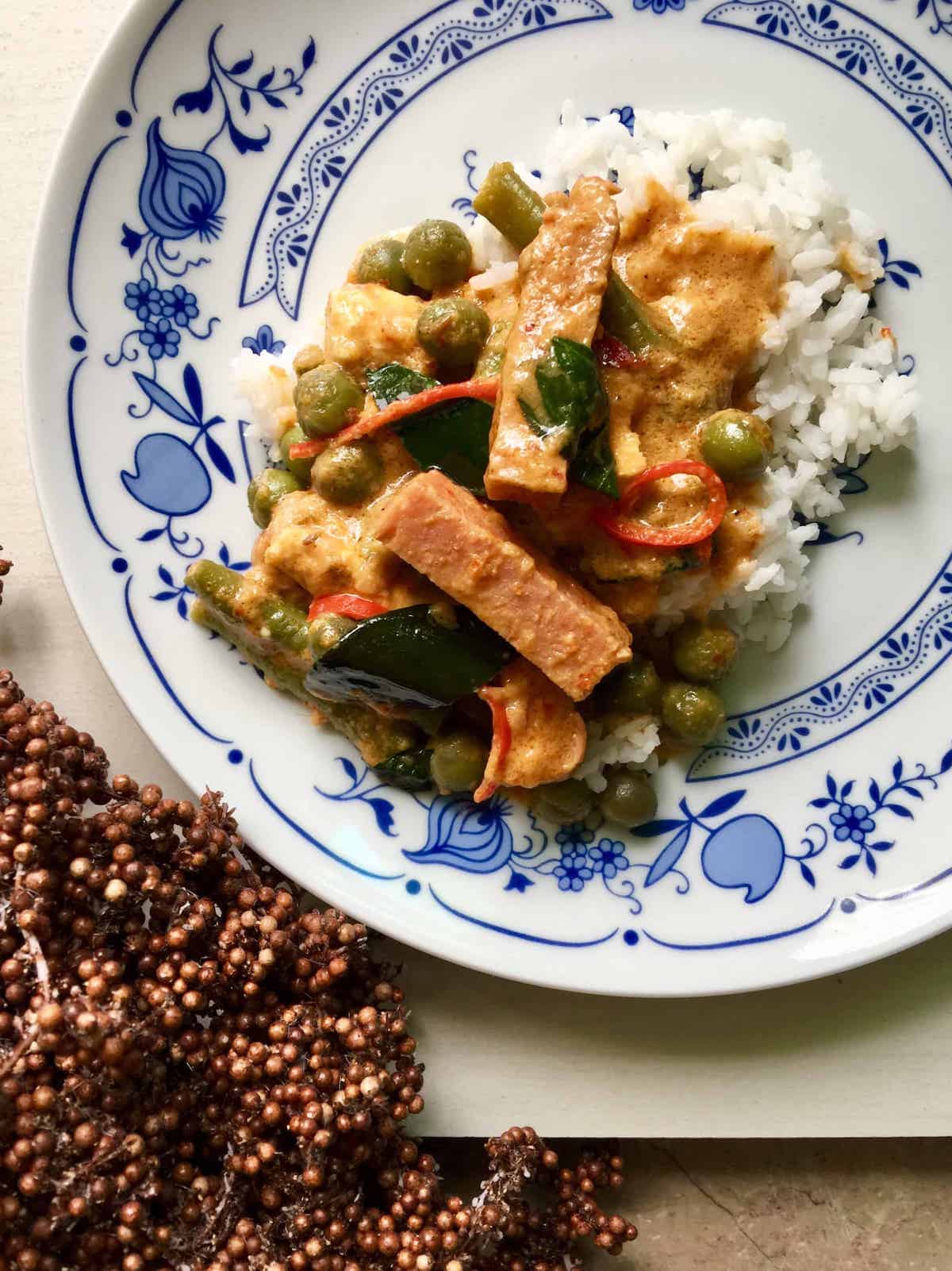
Jump to:
What are Turkey Berries?
Also known as Solanum torvum Sw, Devil's Fig, Terung Pipit, susumber, platebrush, Ma khua Puang and 水茄, the fruit of the turkey berry is small and round, giving rise to yet other name, pea eggplant.
The green small fruits, which are clustered together like grapes, are edible and can be found in many cuisines: in Jamaica (cooked with saltfish and ackee), in India (eaten raw and cooked), in Cote d'Ivoire (in soups and sauces) as well as Thailand (raw in nam phrik (Thai chilli paste) and cooked in Thai green curry.)
Note: Like the tomato, it is part of the nightshade family. Although normally edible, there have been reports of poisoning after eating these berries in NYC and Toronto - apparently, the berries become toxic when environmentally stressed- and it's not recommended to consume it in large doses.
Taste
Raw, the pea eggplant is bitter.
Whilst cooking removes some of the acrid flavor, it is still rather an acquired taste. The fruit is also full of seeds, so it introduces an interesting texture to food, different from regular eggplants.
Health Benefits
Besides being used in food, the turkey berry plants are also part of traditional medicine.
In Malaysia, the root and seeds of the plants have been applied for cracks in the feet and tooth pain respectively. In India, on the other hand, the plant is extracted to treat insect stings and the fruit taken for stomach pain.s
Note: this information is for trivia only and not meant as medical advice. Please always seek qualified professional opinion for health and medical issues.
How to Grow
Turkey berry plants can be grown from seed or stem cuttings and grow in anything from semi-shade to full sun. It is a perennial shrub that can grow up to 2-3m tall but beware the small thorns on the stems, particularly in young plants!
Note: other easy to grow Asian plants are curry leaves, lemongrass, pandan and aloe vera.
Ingredients
My Father lived in Thailand for over 20 years so I spent a lot of time in the country.
However, though inspired by Thai green curry, this isn't a true Thai curry as I don't use cilantro roots in the paste since it's not the most common of ingredients. If you have some, feel free to add it in when you pound (or blend) the curry paste.
For this recipe, you will need:
- pork shoulder butt
- This is my favourite pork for braising as it's tender but not too fatty. You can substitute with other cuts of pork. (Note that using pork belly will release a lot of oil in the curry so you may have to skim the oil off the surface.)
- Alternative: chicken (but the cooking time will change)
- pea eggplants (turkey berries)
- regular eggplants (brinjal/ aubergine)
- You want to slice these thinly to allow the flavor of the sauce to soak right into the flesh
- fresh red chilli
- I substitute with dry chilli when out
- coconut milk
- Substitute: ⅓ Cup coconut cream mixed well with ⅔ Cup water to give you 1Cup of coconut milk
- Use extra to make coconut rice to go with this dish!
- fish sauce
- white granulated sugar & salt to taste
- Substitute: coconut sugar
- Kaffir Lime leaves
- Crushed to release the aroma and sliced thinly if not they'll be too tough to eat
- Do not omit this if not the curry will taste a little flat
- Thai Basil leaves
- Curry paste (please see below)
- If you don't have time to make the curry paste, you can substitute with shop-bought Thai green curry paste
- Optional garnish: fried dried shrimp
For the Thai curry paste, you will need to pound the following in a mortar and pestle, adding them in the order they are listed. I use a blender when in a rush but the flavour isn't quite the same (as blending cuts the cells whilst pounding crushes the cell walls):
- cumin
- black peppercorns
- shrimp paste (belacan)
- salt
- This helps to break down the other ingredients more quickly
- peeled garlic cloves
- An easy way to peel garlic is to put the cloves in a jar, seal it, and shake. All the skins will drop off by themselves!
- galangal
- dried red chillies
- Please remember to remove the seeds if not they'll be super spicy. Soaking the dried chillies first makes them softer and easier to pound. Do NOT touch your eyes after handling the dried chillies or they will burn!
- fresh red chillies
- red onion, minced (they vary in size so you basically want about ½ Cup)
- Substitute: yellow onion and a bit of sugar (as red onion is sweeter) or shallots
- Optional: you can add in a few coriander roots/ stems and some lemongrass if you like
How to Serve
The curry goes well with cooked white rice, coconut pandan rice and sunny-side eggs or these side dishes for curry.
Expert Tips
Tip #1: You can make a big batch of the curry paste then freeze it for up to 1 year. The paste can also be used to fry rice but if you can't take spicy food, you may want to use a little less dried chilli in the curry.
Tip #2: If you're not sure when to stop dry frying the spices, they'll smell fragrant and you'll hear a slightly crackling sound when they're ready. Remember to keep the heat low as spices burn easily!
Tip #3: Always pound the driest ingredients first, before adding the ones with more water content i.e. the onions will be the last addition.
Tip #4: If you find the grinding tough going, add a bit of salt to help you (but remember to reduce the salt or fish sauce when cooking later!)
FAQs
It is eaten raw and cooked in different cuisines- fans of Thai food would mostly likely have eaten this less commonly found vegetable in Thai green curry. However, do note that there have been a few reports of poisoning after eating these berries- apparently, the fruit can become toxic when environmentally stressed.
They're not the most common of vegetables. In Asia, your best bet would be a wet market (or to grow your own- they grow readily in the tropics.) If you live outside of Asia, drop by the closest Asian or Jamaican supermarket to see if they're stocked.
Other Asian Garden Recipes

Thai Pork and Turkey Berry (Pea Eggplant) with Coconut Milk Curry Recipe
Equipment
- mortar and pestle Substitute: blender
- Pan & heat-proof spatula
- Pot
Ingredients
For the curry paste (Substitute: shop bought Thai green curry paste)
- ½ Tablespoon cumin, lightly toasted
- ⅓ teaspoon black peppercorns, lightly toasted
- 1 teaspoon shrimp paste (belacan), toasted
- 1 teaspoon salt Add more if you need it to help break the spices down but remember to add less fish sauce and salt when making the curry later
- 4-5 cloves garlic, peeled
- 1½ Tablespoon galangal
- 11 dried red chillies, seeds removed if not it will be crazy spicy Soak and cut to make pounding them down easier. Substitute with fresh red chillies if necessary. (Don't touch your eyes after handling dried chillies!)
- 4 fresh red chillies, cut into smaller pieces, seeds removed
- 1 red onion (about ½ Cup) Substitute: yellow onions + a pinch of sugar as red onions are sweeter, or shallots
- Optional: you can add in a few coriander roots/ stems and some lemongrass if you like
For the turkey berry curry
- 1 Cup coconut milk Substitute: ⅓ Cup coconut cream mixed with ⅔ Cup water
- 1 lb pork shoulder (453g) Substitute: other cuts of pork or chicken
- 2 eggplants/ aubergines/ brinjal, sliced into small strips
- ⅓ Cup pea eggplants or turkey berries May be cut into half if you like
- 1 Cup Water If the curry becomes too thick after simmering, add more water.
- 2 Tablespoons fish sauce Use less if your fish sauce is very salty, or if you've added more salt to the curry paste above
- 1 Tablespoon white granulated ugar, or to taste Substitute: coconut sugar
- Salt, to taste
- 2-3 kaffir lime leaves, removed from the stem and lightly bruised Slice 1 into thin strips for garnish if you wish. Do not omit these lime leaves or the curry will not be as tasty.
- 1 handful Thai basil leaves
- 1 red chilli, thinly sliced Substitute: dry red chilli
- Dried shrimp, toasted Optional topping for texture
Instructions
For the curry paste
- Lightly toast the cumin seeds, black peppercorns and belacan (do it 1 at a time.)
- Pound the above and the salt in a mortar and pestle. (If you don't have a mortar and pestle, you can use a blender instead.)
- When crushed, add the rest of the ingredients, a bit at time, and pound till everything becomes a paste. (Add the ingredients in the order they are listed.)
For the curry
- Add oil to the wok on medium heat. Once hot, add the curry paste and stir-fry till fragrant.
- Add ½ the coconut milk and stir to mix well. Stir continuously to avoid burning. If it starts to splatter, lower the heat. Continue stirring till the oil separates at the top - the coconut oil is helping to bloom the flavour in the herbs and spices- and the paste becomes aromatic.
- Add the pork to the wok and stir till partially cooked.
- Add the regular eggplants, stir, then pour in the rest of the coconut milk and water.
- Simmer for 10 minutes or till the pork is fully cooked then add the pea eggplants.
- Add the fish sauce, sugar and, if required, salt (taste first as fish sauce is quite salty already) If necessary, add a bit more sugar.
- Stir in the sliced up red chilli and Kaffir Lime Leaves, bring to the boil, add the Thai Basil then immediately switch off the heat (if not the basil will be overcooked and not as bright a green)
- Optional: garnish with more slivers of Kaffir Lime Leaves and some toasted dried shrimp
- Serve with rice.
Notes
Note: the nutritional information is an estimate automatically calculated using the WPRM recipe maker and I am not responsible for its veracity.
Let me know in the comments if you liked this Thai Turkey Berry curry!

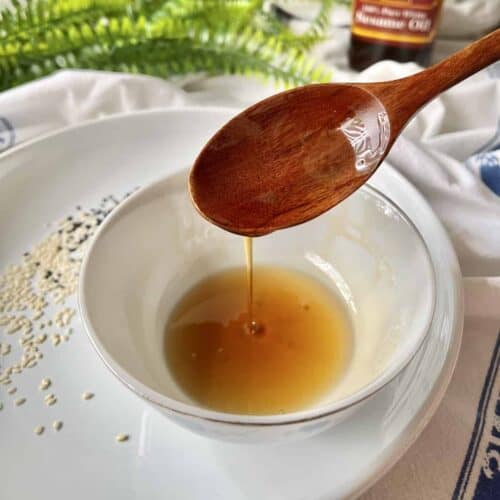

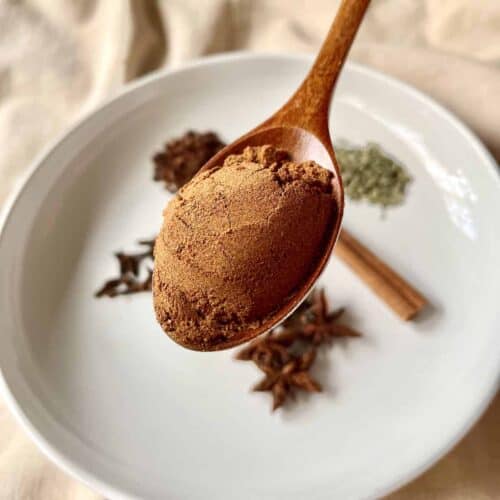

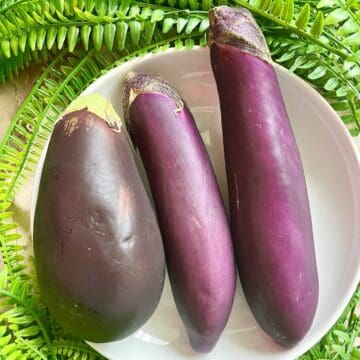
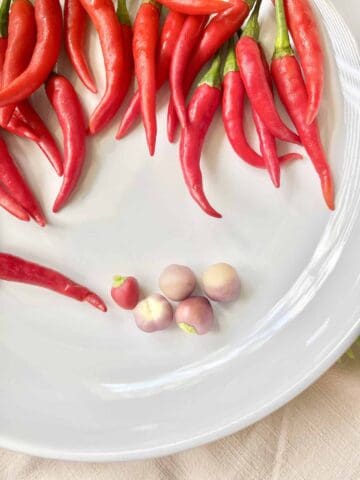
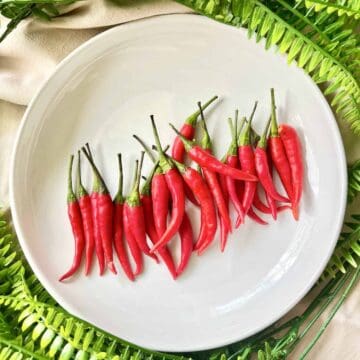
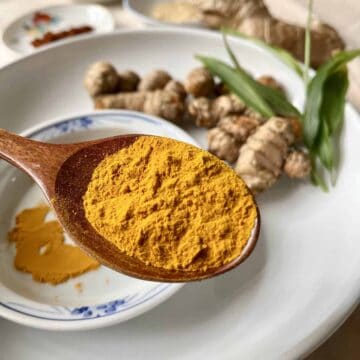
reese says
Made this just now. delicious! never knew what to do with my pea eggplants before this, thanks for sharing
Zen says
Thanks Reese, glad you've found a new recipe, hope you like it!